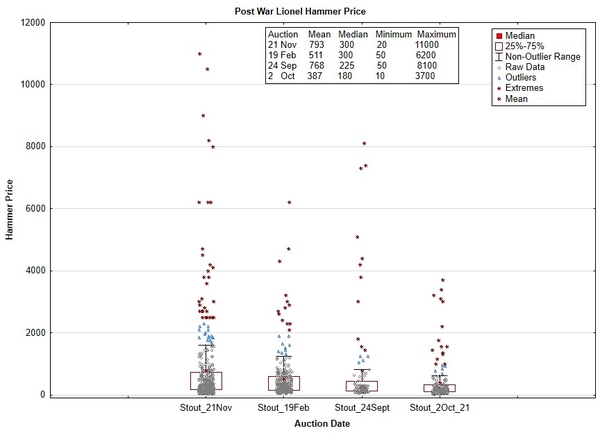The price of the empty box, as we all know, sold due supply, demand and condition. Many boxes are hard to come by. We tore them open and parents threw the boxes in the trash. There are probably less than 5 of these boxes -in all- including collections and somewhere in public hands. Supply then is non-existent, this may have been the only one known. The demand was at least two who wanted it. The box's condition is also a consideration. True collectors have the money to amass their collections and the cost, although high for enthusiasts, is not a concern for them. He was probably buying other stuff the next auction.
Over the past year or so I've recorded the hammer prices for various categories of trains in some of the Stout Auctions. Below is a summary of the hammer prices for Postwar Lionel items in 4 auctions from the past year or so. Included in the tally is anything train including boxes but it does not include paper such as catalogs, flyers, etc. As you can see, all four of these auctions have interesting high price tails and all of them have half of their sales at or below $300 (remember, the median is the 50% point).
Attachments
There are 19 million millionaires in the US, at least before last week. I think most of them are multi-millionaires.
If they had only $1M is savings, that set box only cost them .74% of that savings. If that box was truly rare, that would probably be worth it for a true collector.
As mentioned earlier, I also found it interesting how they sold the whole set by piecing it out, with the box first. Once they had the box, I am sure they had to have the rest.
I'll never understand how a wonderful toy can manage to stay sealed in a box for 65-70 years, or how someone will then spend thousands of dollars to buy that toy just to STILL keep it in its box. Just about any other investment will garner a better ROI. Oh well, to each his own.
I understand what you’re saying about keeping things in a box but I can relate at least one story that someone had found postwar trains in their grandmothers attic’s new in the box evidently she was saving them for his Christmas present and then passed away.
It will be intresting to see what prices are like at York. I am searching for a Lionel Vision Line 700E Hudson.
Collector quality auctions and empty boxes are not for me. Perhaps the Smithsonian one day will have a Lionel building, but I would not bet on it.
I am happy with the Postwar prices so far and feel if I am patient I will find what I want. This family still has our Diesel switcher's, Pacific's, Prairies and Hudson's from the early 50's, and about 2 years ago I 'discovered' the sturdiness and beauty of prewar steamers with stainless steel tires, Baldwin drivers or copper trim. And then, I caught the Berkshire bug bad, especially the 1946 Smoke Bulb variety which ranged from $300 to $700 with a good 2426W tender. I slipped into my niche and slowly acquired quality items at the lower end of the price range.
I have added a dozen or more engines (224, 225, 225E, 249E, 263E and 6 Berkshires) and lots of quality postwar rolling stock. So, if postwar is no longer King, it is far from dead, and as long as inexpensive trains can go round and round, the next generation of 'operators' is assured. They run them too, just as 'we' did 70 years ago. Run is Fun.
But...I do think that I may be stuck with a wee bit of Standard Gauge and Tin buildings, sometimes the prices were just too tempting or the items spiffy and unique. Lesson is to buy not only that which you want, but that which will not be boxed up for another two decades.
Or, wait for the next round of politicians to fund a new building for the Smithsonian...we can vote on that later.






